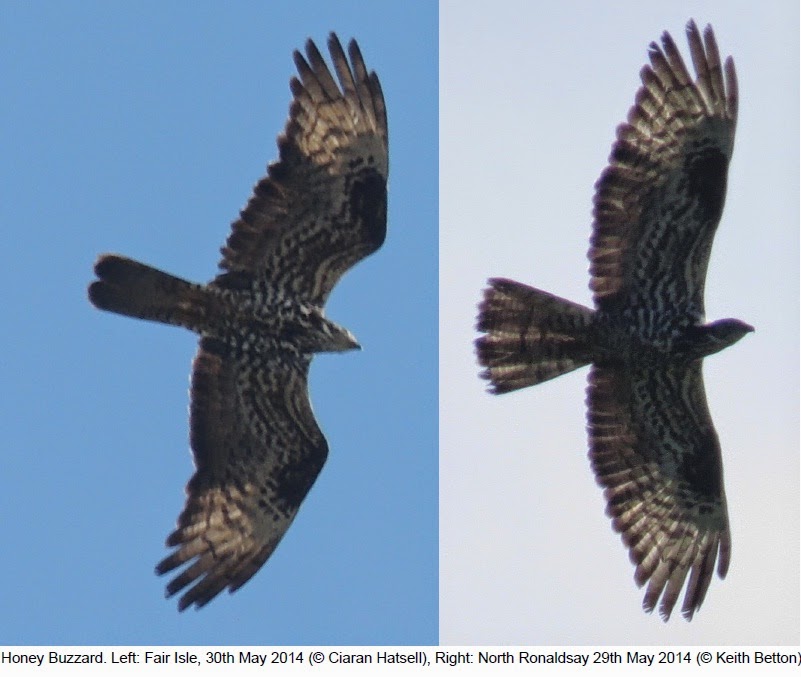After starting the period murky, a couple of days of easterly winds brought sunshine, then rain before the wind switched to the north and things started to feel distinctly cooler. With an increasing swell and grey skies, there was almost an autumnal feel and, as the longest day came and went, there was certainly the sense that the seasons had turned.
 |
| The end of spring, as sun rises on the morning of 22nd June (photo: Ciaran Hatsell) |
After the first
attempt at counting the nesting Arctic Terns on Buness was interrupted by the finding
of the Bridled Tern last week, the first attempt to cross to Shalstane to count
tern nests suffered a similar fate, when two Roseate Terns were discovered on the
rocks there on 24th. It won’t make as many headlines away from Fair Isle, but this
represented only the 4th record for the island and the first multiple occurrence.
Nowhere near as rare, but equally important for the year list was the Sandwich
Tern that called into North Haven briefly on the evening of 26th. Five tern
species in a year is as good as it gets on Fair Isle (the maximum in any
previous year is just four species, with Arctic, Common and Sandwich the most
regular, joined by very occasional vagrants) and the rather good year for
rarities (both national and more local) continues.
 |
| After previous records in May 1988, July 1996 and July 2013, the two Roseate Terns found at Shalstane on Tuesday were a surprise. |
The other
rarity of the period was a Blyth’s Reed Warbler, which was trapped at the Obs
on 25th and was still present to 27th. Remarkably, it was already ringed and
proved to be the bird that had been at Virkie (in the south of Shetland
Mainland) on Sunday. Not a huge distance by any means, but interesting that it
had started apparently reorientating. After an autumn Blyth’s Reed Warbler
trapped on Fair Isle in 1993 that later moved to Sumburgh, this is the second
movement of a ringed bird of this species between here and Shetland (the only movements
involving birds trapped in the UK that I’m aware of).
 |
| The very plain wings and short primary projection are good indicators of Blyth's Reed Warbler, as is the lack of any rufous tone, the overall dull brown coloration and the facial pattern. |
For a species
such as Blyth’s Reed Warbler, a ringing recovery is probably the only way of
proving a movement of an individual between two sites, but for other (particularly
larger) rarities, individual plumage features may also provide clues. Two such
examples have surfaced this week, with the Honey Buzzard seen in late May
looking very like the North Ronaldsay bird of the previous day and a Bridled
Tern picture from Northumberland seemingly now confirming what seemed the most
likely scenario anyway – that the bird on the Farnes is the same individual seen
on Fair Isle.
Despite the
late date, there were still a few migrants on the move with the 25th seeing
Pied Flycatcher, Whinchat, Robin, Woodpigeon and Mealy Redpoll arrive and there
was also Kestrel (22nd), Whitethroat (23rd), 2 Blackcaps (26th) and a new Marsh
Warbler singing at Skerryholm (25th), with the two Marsh Warblers lingering
throughout at the Obs.
There’s
always speculation about birds moving this late in the spring and it seems
possible that some are late overshoots, whilst others (including the Pied Flycatcher
and one of the Blackcaps, both females with brood patches), could be failed
breeders wandering.
On the
subject of breeding birds, it’s still looking relatively positive for the
seabirds, hopefully I’ll get a blog update on the season so far for them posted
soon.It looks like we’ve got northerlies for a while now, so any lingering spring migration will surely be brought to an end, but I’d not rule out anything the way this year has been going.
 |
| Garden Wildlife. Grace and Freyja enjoying the morning sunshine at the Obs. |























+(Ciaran+Hatsell).jpg)









2.jpg)
.jpg)
.jpg)
.jpg)
.jpg)
+from+boat+(Ciaran+Hatsell)+blog.jpg)

+blog.jpg)
+blog.jpg)




